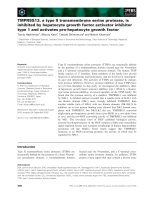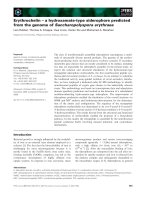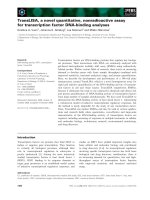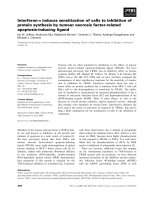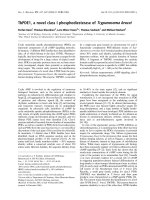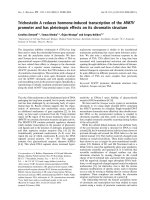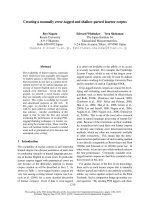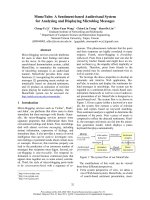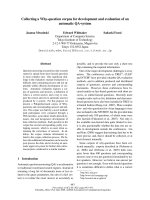Báo cáo khoa học: "Investigating a Generic Paraphrase-based Approach for Relation Extraction" pdf
Bạn đang xem bản rút gọn của tài liệu. Xem và tải ngay bản đầy đủ của tài liệu tại đây (92.57 KB, 8 trang )
Investigating a Generic Paraphrase-based Approach
for Relation Extraction
Lorenza Romano
ITC-irst
via Sommarive, 18
38050 Povo (TN), Italy
Milen Kouylekov
ITC-irst
via Sommarive, 18
38050 Povo (TN), Italy
Idan Szpektor
Department of Computer Science
Bar Ilan University
Ramat Gan, 52900, Israel
Ido Dagan
Department of Computer Science
Bar Ilan University
Ramat Gan, 52900, Israel
Alberto Lavelli
ITC-irst
via Sommarive, 18
38050 Povo (TN), Italy
Abstract
Unsupervised paraphrase acquisition has
been an active research field in recent
years, but its effective coverage and per-
formance have rarely been evaluated. We
propose a generic paraphrase-based ap-
proach for Relation Extraction (RE), aim-
ing at a dual goal: obtaining an applicative
evaluation scheme for paraphrase acquisi-
tion and obtaining a generic and largely
unsupervised configuration for RE. We an-
alyze the potential of our approach and
evaluate an implemented prototype of it
using an RE dataset. Our findings reveal a
high potential for unsupervised paraphrase
acquisition. We also identify the need for
novel robust models for matching para-
phrases in texts, which should address syn-
tactic complexity and variability.
1 Introduction
A crucial challenge for semantic NLP applica-
tions is recognizing the many different ways for
expressing the same information. This seman-
tic variability phenomenon was addressed within
specific applications, such as question answering,
information extraction and information retrieval.
Recently, the problem was investigated within
generic application-independent paradigms, such
as paraphrasing and textual entailment.
Eventually, it would be most appealing to apply
generic models for semantic variability to concrete
applications. This paper investigates the applica-
bility of a generic “paraphrase-based” approach to
the Relation Extraction (RE) task, using an avail-
able RE dataset of protein interactions. RE is
highly suitable for such investigation since its goal
is to exactly identify all the different variations in
which a target semantic relation can be expressed.
Taking this route sets up a dual goal: (a) from
the generic paraphrasing perspective - an objective
evaluation of paraphrase acquisition performance
on a concrete application dataset, as well as identi-
fying the additional mechanisms needed to match
paraphrases in texts; (b) from the RE perspective -
investigating the feasibility and performance of a
generic paraphrase-based approach for RE.
Our configuration assumes a set of entailing
templates (non-symmetric “paraphrases”) for the
target relation. For example, for the target rela-
tion “X interact with Y” we would assume a set of
entailing templates as in Tables 3 and 7. In addi-
tion, we require a syntactic matching module that
identifies template instances in text.
First, we manually analyzed the protein-
interaction dataset and identified all cases in which
protein interaction is expressed by an entailing
template. This set a very high idealized upper
bound for the recall of the paraphrase-based ap-
proach for this dataset. Yet, obtaining high cover-
age in practice would require effective paraphrase
acquisition and lexical-syntactic template match-
ing. Next, we implemented a prototype that uti-
lizes a state-of-the-art method for learning en-
tailment relations from the web (Szpektor et al.,
2004), the Minipar dependency parser (Lin, 1998)
and a syntactic matching module. As expected,
the performance of the implemented system was
much lower than the ideal upper bound, yet ob-
taining quite reasonable practical results given its
unsupervised nature.
The contributions of our investigation follow
409
the dual goal set above. To the best of our knowl-
edge, this is the first comprehensive evaluation
that measures directly the performance of unsuper-
vised paraphrase acquisition relative to a standard
application dataset. It is also the first evaluation of
a generic paraphrase-based approach for the stan-
dard RE setting. Our findings are encouraging for
both goals, particularly relative to their early ma-
turity level, and reveal constructive evidence for
the remaining room for improvement.
2 Background
2.1 Unsupervised Information Extraction
Information Extraction (IE) and its subfield Rela-
tion Extraction (RE) are traditionally performed
in a supervised manner, identifying the different
ways to express a specific information or relation.
Given that annotated data is expensive to produce,
unsupervised or weakly supervised methods have
been proposed for IE and RE.
Yangarber et al. (2000) and Stevenson and
Greenwood (2005) define methods for automatic
acquisition of predicate-argument structures that
are similar to a set of seed relations, which rep-
resent a specific scenario. Yangarber et al. (2000)
approach was evaluated in two ways: (1) manually
mapping the discovered patterns into an IE system
and running a full MUC-style evaluation; (2) using
the learned patterns to perform document filtering
at the scenario level. Stevenson and Greenwood
(2005) evaluated their method through document
and sentence filtering at the scenario level.
Sudo et al. (2003) extract dependency subtrees
within relevant documents as IE patterns. The goal
of the algorithm is event extraction, though perfor-
mance is measured by counting argument entities
rather than counting events directly.
Hasegawa et al. (2004) performs unsupervised
hierarchical clustering over a simple set of fea-
tures. The algorithm does not extract entity pairs
for a given relation from a set of documents but
rather classifies all relations in a large corpus. This
approach is more similar to text mining tasks than
to classic IE problems.
To conclude, several unsupervised approaches
learn relevant IE templates for a complete sce-
nario, but without identifying their relevance to
each specific relation within the scenario. Accord-
ingly, the evaluations of these works either did not
address the direct applicability for RE or evaluated
it only after further manual postprocessing.
2.2 Paraphrases and Entailment Rules
A generic model for language variability is us-
ing paraphrases, text expressions that roughly con-
vey the same meaning. Various methods for auto-
matic paraphrase acquisition have been suggested
recently, ranging from finding equivalent lexical
elements to learning rather complex paraphrases
at the sentence level
1
.
More relevant for RE are “atomic” paraphrases
between templates, text fragments containing vari-
ables, e.g. ‘X buy Y ⇔ X purchase Y’. Under a
syntactic representation, a template is a parsed text
fragment, e.g. ‘X
subj
← interact
mod
→ with
pcomp−n
→ Y’
(based on the syntactic dependency relations of
the Minipar parser). The parses include part-of-
speech tags, which we omit for clarity.
Dagan and Glickman (2004) suggested that a
somewhat more general notion than paraphrasing
is that of entailment relations. These are direc-
tional relations between two templates, where the
meaning of one can be entailed from the meaning
of the other, e.g. ‘X bind to Y ⇒ X interact with Y’.
For RE, when searching for a target relation, it is
sufficient to identify an entailing template since it
implies that the target relation holds as well. Un-
der this notion, paraphrases are bidirectional en-
tailment relations.
Several methods extract atomic paraphrases by
exhaustively processing local corpora (Lin and
Pantel, 2001; Shinyama et al., 2002). Learn-
ing from a local corpus is bounded by the cor-
pus scope, which is usually domain specific (both
works above processed news domain corpora). To
cover a broader range of domains several works
utilized the Web, while requiring several manu-
ally provided examples for each input relation,
e.g. (Ravichandran and Hovy, 2002). Taking a
step further, the TEASE algorithm (Szpektor et al.,
2004) provides a completely unsupervised method
for acquiring entailment relations from the Web
for a given input relation (see Section 5.1).
Most of these works did not evaluate their re-
sults in terms of application coverage. Lin and
Pantel (2001) compared their results to human-
generated paraphrases. Shinyama et al. (2002)
measured the coverage of their learning algorithm
relative to the paraphrases present in a given cor-
pus. Szpektor et al. (2004) measured “yield”, the
number of correct rules learned for an input re-
1
See the 3rd IWP workshop for a sample of recent works
on paraphrasing ( />410
lation. Ravichandran and Hovy (2002) evaluated
the performance of a QA system that is based
solely on paraphrases, an approach resembling
ours. However, they measured performance using
Mean Reciprocal Rank, which does not reveal the
actual coverage of the learned paraphrases.
3 Assumed Configuration for RE
Phenomenon Example
Passive form ‘Y is activated by X’
Apposition ‘X activates its companion, Y’
Conjunction ‘X activates prot3 and Y’
Set ‘X activates two proteins, Y and Z’
Relative clause ‘X, which activates Y’
Coordination ‘X binds and activates Y’
Transparent head ‘X activates a fragment of Y’
Co-reference ‘X is a kinase, though it activates Y’
Table 1: Syntactic variability phenomena, demon-
strated for the normalized template ‘X activate Y’.
The general configuration assumed in this pa-
per for RE is based on two main elements: a list
of lexical-syntactic templates which entail the re-
lation of interest and a syntactic matcher which
identifies the template occurrences in sentences.
The set of entailing templates may be collected ei-
ther manually or automatically. We propose this
configuration both as an algorithm for RE and as
an evaluation scheme for paraphrase acquisition.
The role of the syntactic matcher is to iden-
tify the different syntactic variations in which tem-
plates occur in sentences. Table 1 presents a list
of generic syntactic phenomena that are known in
the literature to relate to linguistic variability. A
phenomenon which deserves a few words of ex-
planation is the “transparent head noun” (Grish-
man et al., 1986; Fillmore et al., 2002). A trans-
parent noun N1 typically occurs in constructs of
the form ‘N1 preposition N2’ for which the syn-
tactic relation involving N1, which is the head of
the NP, applies to N2, the modifier. In the example
in Table 1, ‘fragment’ is the transparent head noun
while the relation ‘activate’ applies to Y as object.
4 Manual Data Analysis
4.1 Protein Interaction Dataset
Bunescu et al. (2005) proposed a set of tasks re-
garding protein name and protein interaction ex-
traction, for which they manually tagged about
200 Medline abstracts previously known to con-
tain human protein interactions (a binary symmet-
ric relation). Here we consider their RE task of
extracting interacting protein pairs, given that the
correct protein names have already been identi-
fied. All protein names are annotated in the given
gold standard dataset, which includes 1147 anno-
tated interacting protein pairs. Protein names are
rather complex, and according to the annotation
adopted by Bunescu et al. (2005) can be substrings
of other protein names (e.g., <prot> <prot>
GITR </prot> ligand </prot>). In such
cases, we considered only the longest names and
protein pairs involving them. We also ignored all
reflexive pairs, in which one protein is marked
as interacting with itself. Altogether, 1052 inter-
actions remained. All protein names were trans-
formed into symbols of the type ProtN, where N
is a number, which facilitates parsing.
For development purposes, we randomly split
the abstracts into a 60% development set (575 in-
teractions) and a 40% test set (477 interactions).
4.2 Dataset analysis
In order to analyze the potential of our approach,
two of the authors manually annotated the 575 in-
teracting protein pairs in the development set. For
each pair the annotators annotated whether it can
be identified using only template-based matching,
assuming an ideal implementation of the configu-
ration of Section 3. If it can, the normalized form
of the template connecting the two proteins was
annotated as well. The normalized template form
is based on the active form of the verb, stripped
of the syntactic phenomena listed in Table 1. Ad-
ditionally, the relevant syntactic phenomena from
Table 1 were annotated for each template instance.
Table 2 provides several example annotations.
A Kappa value of 0.85 (nearly perfect agree-
ment) was measured for the agreement between
the two annotators, regarding whether a protein
pair can be identified using the template-based
method. Additionally, the annotators agreed on
96% of the normalized templates that should be
used for the matching. Finally, the annotators
agreed on at least 96% of the cases for each syn-
tactic phenomenon except transparent heads, for
which they agreed on 91% of the cases. This high
level of agreement indicates both that template-
based matching is a well defined task and that nor-
malized template form and its syntactic variations
are well defined notions.
Several interesting statistics arise from the an-
411
Sentence Annotation
We have crystallized a complex between human FGF1 and
a two-domain extracellular fragment of human FGFR2.
• template: ‘complex between X and Y’
• transparent head: ‘fragment of X’
CD30 and its counter-receptor CD30 ligand (CD30L) are
members of the TNF-receptor / TNFalpha superfamily and
function to regulate lymphocyte survival and differentiation.
• template: ‘X’s counter-receptor Y’
• apposition
• co-reference
iCdi1, a human G1 and S phase protein phosphatase that
associates with Cdk2.
• template: ‘X associate with Y’
• relative clause
Table 2: Examples of annotations of interacting protein pairs. The annotation describes the normalized
template and the different syntactic phenomena identified.
Template f Template f Template f
X interact with Y 28 interaction of X with Y 12 X Y interaction 5
X bind to Y 22 X associate with Y 11 X interaction with Y 4
X Y complex 17 X activate Y 6 association of X with Y 4
interaction between X and Y 16 binding of X to Y 5 X’s association with Y 3
X bind Y 14 X form complex with Y 5 X be agonist for Y 3
Table 3: The 15 most frequent templates and their instance count (f) in the development set.
notation. First, 93% of the interacting protein pairs
(537/575) can be potentially identified using the
template-based approach, if the relevant templates
are provided. This is a very promising finding,
suggesting that the template-based approach may
provide most of the requested information. We
term these 537 pairs as template-based pairs. The
remaining pairs are usually expressed by complex
inference or at a discourse level.
Phenomenon % Phenomenon %
transparent head 34 relative clause 8
apposition 24 co-reference 7
conjunction 24 coordination 7
set 13 passive form 2
Table 4: Occurrence percentage of each syntactic
phenomenon within template-based pairs (537).
Second, for 66% of the template-based pairs
at least one syntactic phenomenon was annotated.
Table 4 contains the occurrence percentage of each
phenomenon in the development set. These results
show the need for a powerful syntactic matcher on
top of high performance template acquisition, in
order to correctly match a template in a sentence.
Third, 175 different normalized templates were
identified. For each template we counted its tem-
plate instances, the number of times the tem-
plate occurred, counting only occurrences that ex-
press an interaction of a protein pair. In total,
we counted 341 template instances for all 175
templates. Interestingly, 50% of the template in-
stances (184/341) are instances of the 21 most fre-
quent templates. This shows that, though protein
interaction can be expressed in many ways, writ-
ers tend to choose from among just a few common
expressions. Table 3 presents the most frequent
templates. Table 5 presents the minimal number
of templates required to obtain the range of differ-
ent recall levels.
Furthermore, we grouped template variants
that are based on morphological derivations (e.g.
‘X interact with Y’ and ‘X Y interaction’)
and found that 4 groups, ‘X interact with Y’,
‘X bind to Y’, ‘X associate with Y’ and ‘X com-
plex with Y’, together with their morphological
derivations, cover 45% of the template instances.
This shows the need to handle generic lexical-
syntactic phenomena, and particularly morpholog-
ical based variations, separately from the acquisi-
tion of normalized lexical syntactic templates.
To conclude, this analysis indicates that the
template-based approach provides very high cov-
erage for this RE dataset, and a small number of
normalized templates already provides significant
recall. However, it is important to (a) develop
a model for morphological-based template vari-
ations (e.g. as encoded in Nomlex (Macleod et
al., )), and (b) apply accurate parsing and develop
syntactic matching models to recognize the rather
412
complex variations of template instantiations in
text. Finally, we note that our particular figures
are specific to this dataset and the biological ab-
stracts domain. However, the annotation and anal-
ysis methodologies are general and are suggested
as highly effective tools for further research.
R(%) # templates R(%) # templates
10 2 60 39
20 4 70 73
30 6 80 107
40 11 90 141
50 21 100 175
Table 5: The number of most frequent templates
necessary to reach different recall levels within the
341 template instances.
5 Implemented Prototype
This section describes our initial implementation
of the approach in Section 3.
5.1 TEASE
The TEASE algorithm (Szpektor et al., 2004) is
an unsupervised method for acquiring entailment
relations from the Web for a given input template.
In this paper we use TEASE for entailment rela-
tion acquisition since it processes an input tem-
plate in a completely unsupervised manner and
due to its broad domain coverage obtained from
the Web. The reported percentage of correct out-
put templates for TEASE is 44%.
The TEASE algorithm consists of 3 steps,
demonstrated in Table 6. TEASE first retrieves
from the Web sentences containing the input tem-
plate. From these sentences it extracts variable in-
stantiations, termed anchor-sets, which are identi-
fied as being characteristic for the input template
based on statistical criteria (first column in Ta-
ble 6). Characteristic anchor-sets are assumed to
uniquely identify a specific event or fact. Thus,
any template that appears with such an anchor-set
is assumed to have an entailment relationship with
the input template. Next, TEASE retrieves from
the Web a corpus S of sentences that contain the
characteristic anchor-sets (second column), hop-
ing to find occurrences of these anchor-sets within
templates other than the original input template.
Finally, TEASE parses S and extracts templates
that are assumed to entail or be entailed by the
input template. Such templates are identified as
maximal most general sub-graphs that contain the
anchor sets’ positions (third column in Table 6).
Each learned template is ranked by number of oc-
currences in S.
5.2 Transformation-based Graph Matcher
In order to identify instances of entailing templates
in sentences we developed a syntactic matcher that
is based on transformations rules. The matcher
processes a sentence in 3 steps: 1) parsing the sen-
tence with the Minipar parser, obtaining a depen-
dency graph
2
; 2) matching each template against
the sentence dependency graph; 3) extracting can-
didate term pairs that match the template variables.
A template is considered directly matched in a
sentence if it appears as a sub-graph in the sen-
tence dependency graph, with its variables instan-
tiated. To further address the syntactic phenomena
listed in Table 1 we created a set of hand-crafted
parser-dependent transformation rules, which ac-
count for the different ways in which syntactic
relationships may be realized in a sentence. A
transformation rule maps the left hand side of the
rule, which strictly matches a sub-graph of the
given template, to the right hand side of the rule,
which strictly matches a sub-graph of the sentence
graph. If a rule matches, the template sub-graph is
mapped accordingly into the sentence graph.
For example, to match the syntactic tem-
plate ‘X(N)
subj
← activate(V)
obj
→ Y(N)’ (POS
tags are in parentheses) in the sentence “Prot1
detected and activated Prot2” (see Figure 1) we
should handle the coordination phenomenon.
The matcher uses the transformation rule
‘Var1
(V) ⇒ and(U)
mod
← Word(V)
conj
→ Var1(V)’
to overcome the syntactic differences. In this
example Var1 matches the verb ‘activate’, Word
matches the verb ‘detect’ and the syntactic rela-
tions for Word are mapped to the ones for Var1.
Thus, we can infer that the subject and object
relations of ‘detect’ are also related to ‘activate’.
6 Experiments
6.1 Experimental Settings
To acquire a set of entailing templates we first ex-
ecuted TEASE on the input template ‘X
subj
← in-
teract
mod
→ with
pcomp−n
→ Y’, which corresponds to
the “default” expression of the protein interaction
2
We chose a dependency parser as it captures directly the
relations between words; we use Minipar due to its speed.
413
Extracted Anchor-set Sentence containing Anchor-set Learned Template
X=‘chemokines’,
Y=‘specific receptors’
Chemokines bind to specific receptors on the target
cells
X
subj
← bind
mod
→
to
pcomp−n
→ Y
X=‘Smad3’, Y=‘Smad4’ Smad3 / Smad4 complexes translocate to the nucleus X Y
nn
→ complex
Table 6: TEASE output at different steps of the algorithm for ‘X
subj
← interact
mod
→ with
pcomp−n
→ Y’.
1. X bind to Y 7. X Y complex 13. X interaction with Y
2. X activate Y 8. X recognize Y 14. X trap Y
3. X stimulate Y 9. X block Y 15. X recruit Y
4. X couple to Y 10. X binding to Y 16. X associate with Y
5. interaction between X and Y 11. X Y interaction 17. X be linked to Y
6. X become trapped in Y 12. X attach to Y 18. X target Y
Table 7: The top 18 correct templates learned by TEASE for ‘X interact with Y’.
detect(V )
subj
ww
p
p
p
p
p
p
p
p
p
p
p
conj
mod
''
N
N
N
N
N
N
N
N
N
N
N
obj
//
P rot2(N )
P rot1(N ) activate(V ) and(U )
Figure 1: The dependency parse graph of the sen-
tence “Prot1 detected and activated Prot2”.
relation. TEASE learned 118 templates for this
relation. Table 7 lists the top 18 learned templates
that we considered as correct (out of the top 30
templates in TEASE output). We then extracted
interacting protein pair candidates by applying the
syntactic matcher to the 119 templates (the 118
learned plus the input template). Candidate pairs
that do not consist of two proteins, as tagged in the
input dataset, were filtered out (see Section 4.1;
recall that our experiments were applied to the
dataset of protein interactions, which isolates the
RE task from the protein name recognition task).
In a subsequent experiment we iteratively ex-
ecuted TEASE on the 5 top-ranked learned tem-
plates to acquire additional relevant templates. In
total, we obtained 1233 templates that were likely
to imply the original input relation. The syntactic
matcher was then reapplied to extract candidate in-
teracting protein pairs using all 1233 templates.
We used the development set to tune a small
set of 10 generic hand-crafted transformation rules
that handle different syntactic variations. To han-
dle transparent head nouns, which is the only phe-
nomenon that demonstrates domain dependence,
we extracted a set of the 5 most frequent trans-
parent head patterns in the development set, e.g.
‘fragment of X’.
In order to compare (roughly) our performance
with supervised methods applied to this dataset, as
summarized in (Bunescu et al., 2005), we adopted
their recall and precision measurement. Their
scheme counts over distinct protein pairs per ab-
stract, which yields 283 interacting pairs in our test
set and 418 in the development set.
6.2 Manual Analysis of TEASE Recall
experiment pairs instances
input 39% 37%
input + iterative 49% 48%
input + iterative + morph 63% 62%
Table 8: The potential recall of TEASE in terms of
distinct pairs (out of 418) and coverage of template
instances (out of 341) in the development set.
Before evaluating the system as a whole we
wanted to manually assess in isolation the cover-
age of TEASE output relative to all template in-
stances that were manually annotated in the devel-
opment set. We considered a template as covered
if there is a TEASE output template that is equal
to the manually annotated template or differs from
it only by the syntactic phenomena described in
Section 3 or due to some parsing errors. Count-
ing these matches, we calculated the number of
template instances and distinct interacting protein
pairs that are covered by TEASE output.
Table 8 presents the results of our analysis. The
414
1st line shows the coverage of the 119 templates
learned by TEASE for the input template ’X inter-
act with Y’. It is interesting to note that, though we
aim to learn relevant templates for the specific do-
main, TEASE learned relevant templates also by
finding anchor-sets of different domains that use
the same jargon, such as particle physics.
We next analyzed the contribution of the itera-
tive learning for the additional 5 templates to recall
(2nd line in Table 8). With the additional learned
templates, recall increased by about 25%, showing
the importance of using the iterative steps.
Finally, when allowing matching between a
TEASE template and a manually annotated tem-
plate, even if one is based on a morphologi-
cal derivation of the other (3rd line in Table 8),
TEASE recall increased further by about 30%.
We conclude that the potential recall of the cur-
rent version of TEASE on the protein interaction
dataset is about 60%. This indicates that signif-
icant coverage can be obtained using completely
unsupervised learning from the web, as performed
by TEASE. However, the upper bound for our cur-
rent implemented system is only about 50% be-
cause our syntactic matching does not handle mor-
phological derivations.
6.3 System Results
experiment recall precision F
1
input 0.18 0.62 0.28
input + iterative 0.29 0.42 0.34
Table 9: System results on the test set.
Table 9 presents our system results for the test
set, corresponding to the first two experiments in
Table 8. The recall achieved by our current imple-
mentation is notably worse than the upper bound
of the manual analysis because of two general set-
backs of the current syntactic matcher: 1) parsing
errors; 2) limited transformation rule coverage.
First, the texts from the biology domain pre-
sented quite a challenge for the Minipar parser.
For example, in the sentences containing the
phrase ‘X bind specifically to Y’ the parser consis-
tently attaches the PP ‘to’ to ‘specifically’ instead
of to ‘bind’. Thus, the template ‘X bind to Y’ can-
not be directly matched.
Second, we manually created a small number of
transformation rules that handle various syntactic
phenomena, since we aimed at generic domain in-
dependent rules. The most difficult phenomenon
to model with transformation rules is transparent
heads. For example, in “the dimerization of Prot1
interacts with Prot2”, the transparent head ‘dimer-
ization of X’ is domain dependent. Transforma-
tion rules that handle such examples are difficult
to acquire, unless a domain specific learning ap-
proach (either supervised or unsupervised) is used.
Finally, we did not handle co-reference resolution
in the current implementation.
Bunescu et al. (2005) and Bunescu and Mooney
(2005) approached the protein interaction RE task
using both handcrafted rules and several super-
vised Machine Learning techniques, which uti-
lize about 180 manually annotated abstracts for
training. Our results are not directly comparable
with theirs because they adopted 10-fold cross-
validation, while we had to divide the dataset into
a development and a test set, but a rough compari-
son is possible. For the same 30% recall, the rule-
based method achieved precision of 62% and the
best supervised learning algorithm achieved preci-
sion of 73%. Comparing to these supervised and
domain-specific rule-based approaches our system
is noticeably weaker, yet provides useful results
given that we supply very little domain specific in-
formation and acquire the paraphrasing templates
in a fully unsupervised manner. Still, the match-
ing models need considerable additional research
in order to achieve the potential performance sug-
gested by TEASE.
7 Conclusions and Future Work
We have presented a paraphrase-based approach
for relation extraction (RE), and an implemented
system, that rely solely on unsupervised para-
phrase acquisition and generic syntactic template
matching. Two targets were investigated: (a) a
mostly unsupervised, domain independent, con-
figuration for RE, and (b) an evaluation scheme
for paraphrase acquisition, providing a first evalu-
ation of its realistic coverage. Our approach differs
from previous unsupervised IE methods in that we
identify instances of a specific relation while prior
methods identified template relevance only at the
general scenario level.
We manually analyzed the potential of our ap-
proach on a dataset annotated with protein in-
teractions. The analysis shows that 93% of the
interacting protein pairs can be potentially iden-
tified with the template-based approach. Addi-
415
tionally, we manually assessed the coverage of
the TEASE acquisition algorithm and found that
63% of the distinct pairs can be potentially rec-
ognized with the learned templates, assuming an
ideal matcher, indicating a significant potential re-
call for completely unsupervised paraphrase ac-
quisition. Finally, we evaluated our current system
performance and found it weaker than supervised
RE methods, being far from fulfilling the poten-
tial indicated in our manual analyses due to insuf-
ficient syntactic matching. But, even our current
performance may be considered useful given the
very small amount of domain-specific information
used by the system.
Most importantly, we believe that our analysis
and evaluation methodologies for an RE dataset
provide an excellent benchmark for unsupervised
learning of paraphrases and entailment rules. In
the long run, we plan to develop and improve our
acquisition and matching algorithms, in order to
realize the observed potential of the paraphrase-
based approach. Notably, our findings point to the
need to learn generic morphological and syntactic
variations in template matching, an area which has
rarely been addressed till now.
Acknowledgements
This work was developed under the collaboration
ITC-irst/University of Haifa. Lorenza Romano
has been supported by the ONTOTEXT project,
funded by the Autonomous Province of Trento un-
der the FUP-2004 research program.
References
Razvan Bunescu and Raymond J. Mooney. 2005. Sub-
sequence kernels for relation extraction. In Proceed-
ings of the 19th Conference on Neural Information
Processing Systems, Vancouver, British Columbia.
Razvan Bunescu, Ruifang Ge, Rohit J. Kate, Ed-
ward M. Marcotte, Raymond J. Mooney, Arun K.
Ramani, and Yuk Wah Wong. 2005. Comparative
experiments on learning information extractors for
proteins and their interactions. Artificial Intelligence
in Medicine, 33(2):139–155. Special Issue on Sum-
marization and Information Extraction from Medi-
cal Documents.
Ido Dagan and Oren Glickman. 2004. Probabilis-
tic textual entailment: Generic applied modeling of
language variability. In Proceedings of the PAS-
CAL Workshop on Learning Methods for Text Un-
derstanding and Mining, Grenoble, France.
Charles J. Fillmore, Collin F. Baker, and Hiroaki Sato.
2002. Seeing arguments through transparent struc-
tures. In Proceedings of the 3rd International
Conference on Language Resources and Evaluation
(LREC 2002), pages 787–791, Las Palmas, Spain.
Ralph Grishman, Lynette Hirschman, and Ngo Thanh
Nhan. 1986. Discovery procedures for sublanguage
selectional patterns: Initial experiments. Computa-
tional Linguistics, 12(3).
Takaaki Hasegawa, Satoshi Sekine, and Ralph Grish-
man. 2004. Discoverying relations among named
entities from large corpora. In Proceedings of the
42nd Annual Meeting of the Association for Compu-
tational Linguistics (ACL 2004), Barcelona, Spain.
Dekang Lin and Patrick Pantel. 2001. Discovery of in-
ference rules for question answering. Natural Lan-
guage Engineering, 7(4):343–360.
Dekang Lin. 1998. Dependency-based evaluation on
MINIPAR. In Proceedings of LREC-98 Workshop
on Evaluation of Parsing Systems, Granada, Spain.
Catherine Macleod, Ralph Grishman, Adam Meyers,
Leslie Barrett, and Ruth Reeves. Nomlex: A lexi-
con of nominalizations. In Proceedings of the 8th
International Congress of the European Association
for Lexicography, Liege, Belgium.
Deepak Ravichandran and Eduard Hovy. 2002. Learn-
ing surface text patterns for a Question Answering
system. In Proceedings of the 40th Annual Meet-
ing of the Association for Computational Linguistics
(ACL 2002), Philadelphia, PA.
Yusuke Shinyama, Satoshi Sekine, Kiyoshi Sudo, and
Ralph Grishman. 2002. Automatic paraphrase ac-
quisition from news articles. In Proceedings of
the Human Language Technology Conference (HLT
2002), San Diego, CA.
Mark Stevenson and Mark A. Greenwood. 2005. A
semantic approach to IE pattern induction. In Pro-
ceedings of the 43rd Annual Meeting of the Associa-
tion for Computational Linguistics (ACL 2005), Ann
Arbor, Michigan.
K. Sudo, S. Sekine, and R. Grishman. 2003. An im-
proved extraction pattern representation model for
automatic IE pattern acquisition. In Proceedings of
the 41st Annual Meeting of the Association for Com-
putational Linguistics (ACL 2003), Sapporo, Japan.
Idan Szpektor, Hristo Tanev, Ido Dagan, and Bonaven-
tura Coppola. 2004. Scaling web-based acquisi-
tion of entailment relations. In Proceedings of the
2004 Conference on Empirical Methods in Natural
Language Processing (EMNLP 2004), Barcelona,
Spain.
Roman Yangarber, Ralph Grishman, Pasi Tapanainen,
and Silja Huttunen. 2000. Automatic acquisition
of domain knowledge for information extraction. In
Proceedings of the 18th International Conference on
Computational Linguistics, Saarbruecken, Germany.
416
